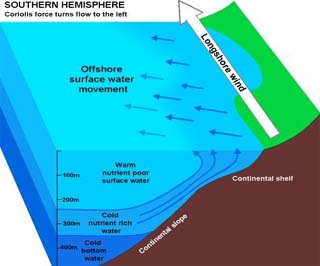Here is information to help you understand what makes the water off the coast of Peru so unique and valuable to the fishing industry. There are only five places on Earth that have a current system like this, but the Peruvian coast is the richest. Coastal upwelling in the Peruvian Current System makes the coastal water nutrient-rich. The mechanism to understand this is provided below.
|
The world's most productive coastal upwelling region is the 300 x 33 miles off the coast of Peru. In the seven-month fishing season of 1969-70, 11 million metric tons (mmt) of Peruvian anchoveta (Engraulis ringens) were harvested in this region. Over 10 trillion anchoveta are needed to make 11 mmt. Comparatively, the total U.S. harvest for all species of fish and shellfish in 1969 was 2.5 mmt. The Peruvian Current System is comprised of four distinct currents. The Peru Coastal Current flows northward. It runs deep and hugs land from about Valparaiso, Chile to Chimbote, Peru. The Peru Oceanic Current also flows northward, but further out to sea. It runs several hundred miles wide and 700 meters deep, and flows north to a point opposite Gulf of Guayaquil before bending west.. The Peru Coastal Countercurrent flow southward between these two currents. And the Peru Undercurrent runs southward beneath all three surface currents. South and southeast tradewinds blowing across the Andes Mountains deflect surface water to the west (i.e. left) due to the Coriolis effect. Deep ocean water rich with nutrients like N & P move up to replace the displaced surface water. This constant renewal of phosphates and nitrates stimulate phytoplankton growth totaling from 45 to 200 mg of carbon fixed photosynthetically per cubic m of water each day. |
|
|
image source: www.geol.umd.edu/~jmerck/galsite/research/projects/fitz/ocean2.html Coastal upwelling fluctuates seasonally with its greatest intensity and most disperse during winter, and weakest during summer. The availability of nitrates and phosphates fluctuate accordingly. N & P are most abundant and dispersed during the southern winter (May, June, July, and August). How do you think the seasonal fluctuation of upwelling activity might influence the phytoplankton population? |
HOW DOES IT WORK?
- In the southern hemisphere, the Coriolis effect deflects southward blowing longshore wind to the left.
- This moves the warm, nutrient-poor surface water offshore.
- Cold, nutrient-rich bottom water moves to the surface along the continental slope to replace the offshore moving surface water.
- It is the transport of nitrogen and phosphorous nutrients from the ocean bottom to the surface that makes upwelling such an important activity.
Coastal upwelling occurs more easily along narrow continental slopes, and usually along the western coasts of continents in both the northern and southern hemispheres. Its strength amount of upwelled nutrient varies seasonally. Off the Peruvian coast, upwelling peaks in the summer. While these regions make up about 0.1% of the ocean's surface, they provide ~40% of all the commercial fish captured globally.
- Why is nitrogen and phosphorous so important?
- What do you think will happen if the amount of upwelled nutrients were to increase or decrease?
- Coastal upwelling is a large ecological activity. Can this be interrupted or altered?
- How does coastal upwelling off the coast of Peru affect the abundance of anchovies?
(www.volvooceanadventure.org/article.php/rz_1_rom_01_rl_00100_00300.html and Glantz, 2001)

This web site was created by Lynn Tran at the North Carolina State University, Department of Mathematics, Science, and Technology Education on 7/12/03. Faculty advisor Dr. David Eggleston, NCSU, Department of Marine, Earth, & Atmospheric Sciences. Last updated December 29, 2003 .
